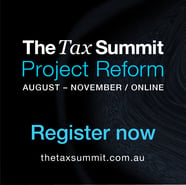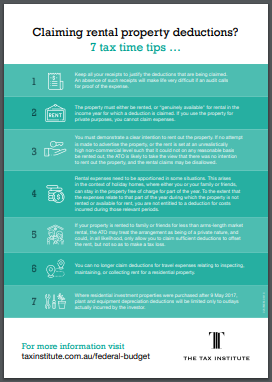Wheels are in motion to explore new territories here at The Tax Summit: Project Reform, with yesterday’s Focus session examining Business Taxation: Small Business Tax Concessions and marking the mid-way point of the series.
Experts Leanne Connor, CTA, WGC Business Advisors and Linda Tapiolas, CTA, Cooper Grace Ward Lawyers, joined facilitator Robyn Jacobson, CTA, Senior Advocate, The Tax Institute for an engaging discussion on the available small business concessions.
We’ve summarised some of the issues and highlights in this article.

There’s more where this came from. Register for a Full Access Virtual Pass to The Tax Summit: Project Reform, to watch all past sessions from the event lineup and dive into upcoming Focus sessions and Keynotes.
25 concessions – different dates, thresholds and eligibility criteria
The available concessions for small businesses stack up at a count of 25, with different start dates, different thresholds and different eligibility criteria. With a stroke of a brush, the Government updated ten of these concessions in the Federal Budget 2020–21 including those relating to the full expensing of depreciating assets, simplified trading stock rules and an immediate deduction for certain start-up and prepaid expenses, to name a few.
In a frank discussion with our speakers, the starting question of “why” kicked off and a critical lens was applied on whether the concessions remain fit for purpose and in line with policy intent.
“Concessions are theoretically given to a targeted group of taxpayers for a particular reason… What is the motivation to giving these concessions for certain targeted taxpayers?” Leanne opened to kick off the dialogue.
The challenges posed by the different dates, thresholds and eligibility criteria for businesses and their advisers was recognised. Keeping up to date and applying the rules is going to result in “lots of mistakes made because there is so much confusion,” Linda observed.
Board of Taxation – 2019 Review
The guiding principles and headline recommendations that came out of the Board’s Report were recognised as carrying merit but still pending response from the Government.
Recommendations such as reforming the small business CGT concessions and the grouping rules were welcomed. There was overarching concern that the unincorporated small business tax discount and some specific small business rules (e.g. simplified trading stock, small business pooling of depreciating assets etc.) may not be easily understood.
Leanne noted that for the purposes of reforming certain regimes e.g. small business restructure rollover, it is critical to consider “whether the rules have application to advisers who are willing to go through that process for their clients [in the SME sector]”.
In addition, Linda mentioned the reduced tax rates for entities in the SME sector, “when you actually look at that base rate entity, it seems like in a lot of cases that is it actually a penalty… they are basically losing franking credits as the tax rate drops.” The corporate tax rates for base rate entities was discussed in greater detail in our discussion of taxation of business income and entity structuring issues relevant to SMEs in Focus Session 2.
Over-complicated system and abolition is not off the table
The discussion continued as Robyn and our speakers delved into issues such as the increased complexity due to the variation in thresholds for different measures, the practical application of the law and the costs associated with determining eligibility to access a concession being disproportionate to the benefit received.
Linda indicated that the family trust election rules are so complicated that complete abolition of the rules would be a welcome possibility to address the negative tax implications.
Ongoing case law on issues such as the active asset test and the $6 million maximum net asset value test, including the recent Full Federal Court judgment in Eichmann and Tribunal decisions in Rus and Karapanagiotidis, further demonstrate that the rules are complex.
Hurdles to entry and disproportionate costs
On the topic of existing barriers to businesses to gain access to SME concessions, Leanne said that efficiency and simplicity are the key priorities, as well as maintaining integrity.
“If you recognise that 60% of small businesses are individuals and potentially under the $2 million turnover [threshold], then the hurdles to entry are often a lack of understanding of the rules, which one applies, when it applies and be able to work your way through the minefield. We go back to the age old problem of Rumsfeld of “unknown unknowns,” observed Linda.
“If you don’t know something or if you are not aware of the concession or how to apply it, you run the risk of not having a go because you don’t understand it or you get it wrong. Both of those are unacceptable outcomes when [the concessions] are there to assist the taxpayers,” she continued.
Leanne added that, in fairness, some of the SME concessions such as the GST concessions and those addressing timing differences of payments, do effectively bring alleviation to small businesses however some are highly complex.
“It is unfortunate we have such a complex range of measures targeted to people who don’t have the resources to be able to understand it. Or we end up with the costs outweighing the benefits which is something we are not trying to do.”
Life cycle of SMEs and their unique problems
In the spirit of each of our sessions being live and interactive, the speakers addressed some comments raised by our engaged audience, including whether our tax system should be neutral between large and small businesses and whether the current administration of tax disproportionately burdens smaller businesses.
Leanne took a step back to firstly address the taxpayers being targeted, understanding their profile and unique life cycle stage. “SMEs issues are lack of resources, to innovation, finance, managerial or technical support or perhaps, retirement options and cash flow. If you accept that these are some of the issues we need to target, then these SME concessions should be there to assist small businesses that are unique to them.”
Linda agreed that there are unique differences between small and large businesses, and recognised the benefit of the ability to purchase replacement, active assets, noting that the tax can be delayed so long as the amounts are being recycled back into the business.
In addition, a pathway of reform was considered by Linda on whether there should be an election to opt out of the base rate entity rules. “From a structuring perspective, it is becoming a lot more complex. Businesses in the SME sector are likely to want to opt out in an attempt to not lose franking credits. There may be more integrity measures around because of perceived unfairness.”
There was also a detailed conversation about understanding the life cycle of a small business and the tax system providing the benefits when needed by a business.
“As advisers for our small business clients, we are trying to get them over the hurdle, to get them from A to B with the concessions aimed to provide the benefit when it is needed. Small businesses are fundamental for our economy,” Leanne said.
In the context of transactions, “when you do restructures, always think of your next transaction. People generally restructure, not necessarily for tax reasons, but predominately for asset protection especially during times of COVID-19” explained Linda.
Going back to the drawing board
Both speakers agreed that tax reform should have the features of achieving greater efficiency and simplicity, matching the tax treatment to cash flows of small businesses and ensure there is buy-in from all stakeholders for the available small business concessions, especially the CGT concessions.
“The CGT concessions need to be simplified and consolidated, in particular, the four CGT concessions. The 15-year concession has a very narrow application … with an unlimited taxable income free-kick if you can fit into the scope. The majority of SME CGT concessions should go hand in glove with the retirement and superannuation system. There is also a place for rollover and preserving capital,” concluded Leanne.
“We need to also recognise what sort of industry we are looking at e.g. primary producers where there is no cash at the end because it is a transition to the next generation. Tax the cash if it exists otherwise, consideration should be given to rolling it into the next generation to allow taxpayers to afford this transition,” Linda said.
This was just a snapshot of some of the ideas discussed in the session. To listen to all the insights raised, register for a Full Access Virtual Ticket to The Tax Summit: Project Reform, for access to all sessions, past and present.
 |
Leanne Connor, CTA, WGC Business Advisors |
 |
Linda Tapiolas, CTA, Cooper Grace Ward Lawyers |
Have your say.
Head to our member forum, Community, to give your opinion on the topics raised by our speakers. Is complexity necessary to enable facility? Let us know what you think.
.png?width=810&name=0688NAT_Tax_Summit-Project_Reform_Blog-Headers_1024x512%20(2).png)









